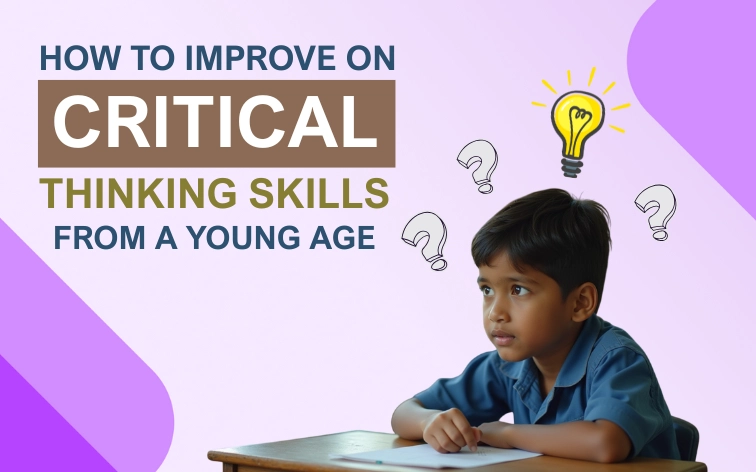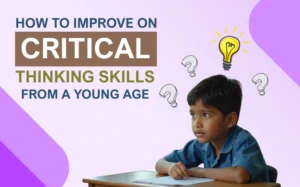Introduction: The Importance of Critical Thinking in Early Years
Have you ever noticed how children bombard you with endless “why” questions? “Why is the sky blue?” “Why do birds fly?” While it might feel exhausting, these moments are golden opportunities to nurture skills of critical thinking – the foundation of lifelong learning.
Critical thinking isn’t just about solving puzzles; it’s about teaching kids to analyze information, question assumptions, and make informed decisions.
Studies show that children as young as five develop these skills through curiosity and play. For instance, the Reboot Foundation found that 20% of people believe critical thinking is best cultivated in early childhood. When kids learn to think critically, they excel academically, solve real-world problems, and even build resilience against misinformation.
Imagine your child confidently evaluating a social media post or creatively tackling a school project – critical thinking makes it possible. Let’s explore how to turn everyday moments into brain-boosting adventures and how to improve critical thinking skills at a young age!
What Are the Skills of Critical Thinking?
What are Critical Thinking Skills? Critical thinking isn’t just a single skill but a toolkit of abilities and how to develop critical thinking skills in students are explained in other sections:
Observation: This skill involves noticing details and patterns in the environment. For example, children might observe how plants grow or how animals interact in nature. By honing their observation skills, they learn to pay attention to the world around them, which is essential for gathering information (e.g., spotting patterns in nature).
Analysis: This is the ability to break down complex information into smaller parts for better understanding. For instance, when comparing characters in a story, children can discuss their motivations and actions, leading to deeper insights about the narrative. Analysis encourages critical engagement with content rather than passive consumption (e.g., comparing story characters).
Inference: Drawing logical conclusions based on evidence is crucial for critical thinking. Children practice inference when they predict outcomes of actions – like anticipating what might happen if a character makes a specific choice in a story. This skill fosters logical reasoning (e.g., predicting outcomes of actions).
Problem-solving: This involves identifying solutions to challenges. For example, when fixing a broken toy, children explore different approaches and learn to test their ideas. This hands-on experience builds resilience and adaptability (e.g., fixing a broken toy).
Communication: Effectively expressing ideas is vital in critical thinking. Children learn to articulate their thoughts clearly during debates or discussions, allowing them to share perspectives and engage with others constructively (e.g., debating a topic).
These skills of critical thinking help children move beyond mere memorization, teaching them how to think critically and creatively about various subjects. For example, analyzing a math problem not only helps them find the answer but also helps with answering the age-old question of how to develop critical thinking skills in students and equips them with the tools to tackle similar challenges in the future.
Role of Parents and Teachers in Nurturing Critical Thinking
Parents and teachers are foundational in shaping critical thinking skills in children. Here’s how they can actively contribute:
- Model Curiosity: Demonstrate curiosity by asking questions like, “Why do stars twinkle?” or “How do plants breathe?” This teaches kids to develop critical thinking skills in students through inquiry-based learning. Share your own problem-solving processes aloud, such as troubleshooting a recipe or planning a trip, to show analytical thinking in action. By showcasing your thought process, you encourage children to adopt a similar approach, fostering an environment where questioning and exploration are valued.
- Encourage Open-Ended Questions: Replace closed questions with prompts like “What would happen if forests disappeared?” or “How might we reduce plastic waste?” These questions push children to analyze causes, effects, and solutions, strengthening skills of critical thinking.
- Create Problem-Solving Scenarios: Assign tasks like planning a weekend budget or designing a rainwater harvesting model. Such activities improve critical thinking skills by merging creativity with logic, as kids weigh options and predict outcomes.
- Promote Collaborative Learning: Organize debates on topics like “Should schools switch to digital textbooks?” Group discussions expose children to diverse viewpoints, refining their ability to evaluate arguments-a core critical thinking skill.
- Provide Feedback on Reasoning: Instead of praising answers, ask, “How did you reach that conclusion?” Highlight gaps in logic gently (“What if we tried this instead?”) to reinforce what critical thinking skills entail: evidence-based reasoning over guesswork.
By blending guidance with independence, adults help children transition from passive learners to active thinkers.
Why Critical Thinking Skills Matters for Students
Skills of critical thinking are vital because they:
- Boost Academic Performance: Analyzing complex themes in literature or solving intricate physics equations requires essential skills like inference and evaluation.
- Combat Misinformation: In today’s digital age filled with information overloads-from social media posts claiming viral trends to misleading news articles; students equipped with strong critical thinking abilities can fact-check claims effectively while discerning credible sources from unreliable ones.
- Enhance Career Readiness: Many professions demand robust problem-solving capabilities; engineers troubleshooting designs rely heavily on analytical reasoning techniques developed throughout education experiences.
- Foster Independence: Choosing college majors involves self-assessment regarding interests versus market demands; this decision-making process blends passion with practicality requiring thoughtful reflection.
Activities to Enhance Critical Thinking at a Young Age
Interactive activities are key to improving critical thinking skills and skills of critical thinking in children. Try these engaging ideas:
Puzzle Challenges: Solve Sudoku, tangrams, or escape room games. These require pattern recognition and strategic planning-core skills of critical thinking. For instance, solving a jigsaw puzzle teaches spatial reasoning and patience.
Science Experiments: Mix baking soda and vinegar to create a volcano reaction. Ask, “Why did the balloon inflate?” Linking cause and effect sharpens inference, a pillar of critical thinking skills.
Story Rewriting: After reading fairy tales or any kids stories, have kids create an alternate ending where she starts a business. This boosts creativity and analysis, key skills of critical thinking.
Budget Simulations: Give ₹500 to plan a meal. Kids compare prices, prioritize ingredients, and calculate costs, developing critical thinking skills through real-world math.
Role-Playing Mysteries: Act as detectives solving a “missing cookie” case. Children gather clues, eliminate red herrings, and justify conclusions-practicing evidence evaluation, a vital critical thinking skill.
These activities transform abstract concepts into hands-on learning, making how to improve critical thinking skills both fun and impactful.
Conclusion: Building a Future with Strong Thinkers
Critical thinking isn’t a luxury-it’s a necessity. By fostering skills of critical thinking early, we equip kids to face tomorrow’s challenges with confidence. Start small: listen to their “why” questions, play strategy games, and let them explore passions.
Remember, every moment is a chance to build a sharper, more curious mind. Together, we’re raising a generation of innovators, problem-solvers, and lifelong learners!




